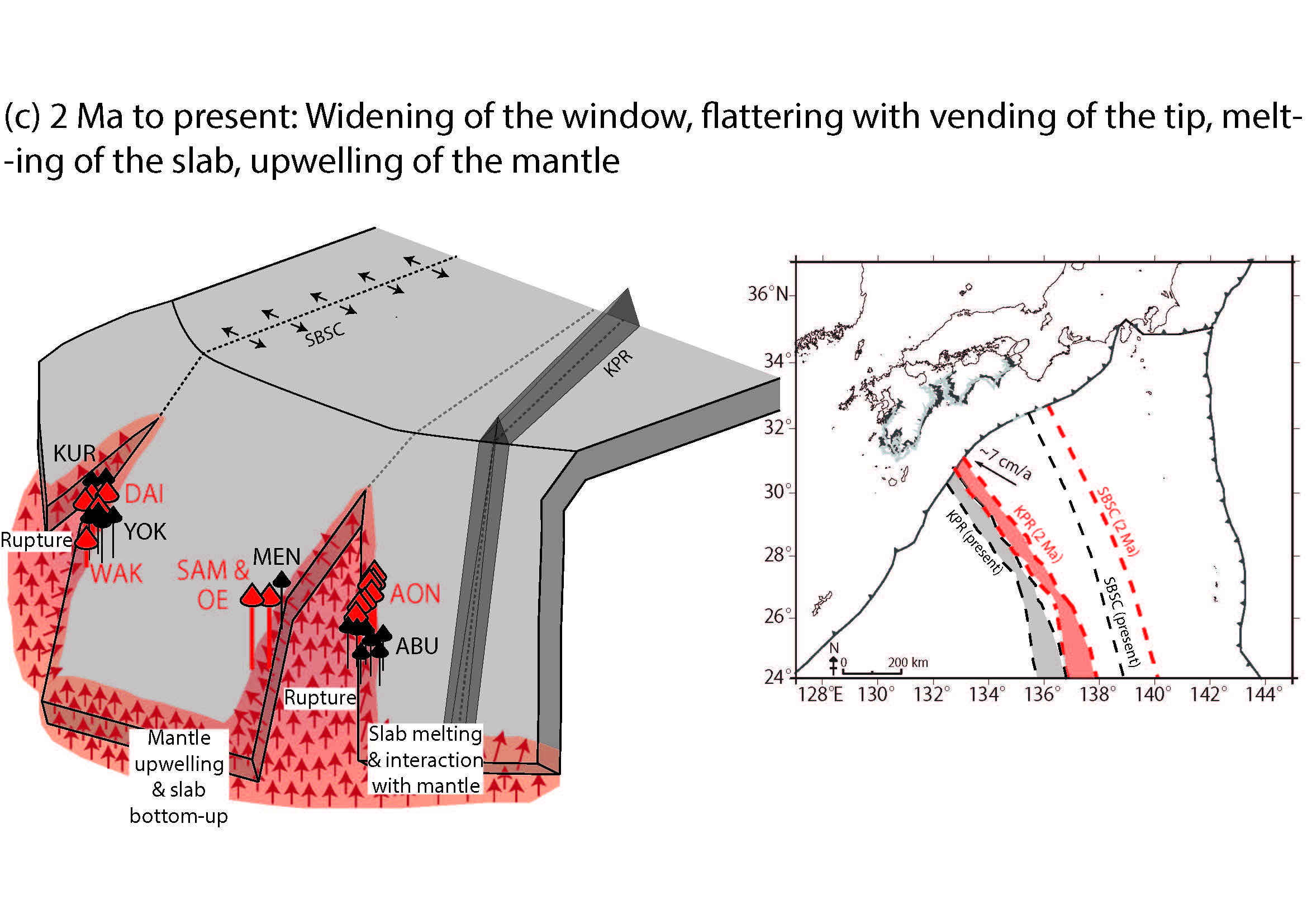Slab controlled petrogenesis of High-Sr intermediate and felsic (adakitic) as a result of the propagating slab tear in a hot subduction system
In subduction zone, oceanic lithosphere sinks into the mantle and the crustal layer of subducting oceanic lithosphere (slab) progressively metamorphoses with increasing depth. Fluids released from the slab lead to hydration and melting of the overlying mantle and formation of volcanic arcs. When a young (less than 25 Myr) and hot slab subducts, it can partially melt leading to the evolution of magmas of intermediate to felsic compositions. It was noted by some studies a peculiar geochemical characteristics of these magmas such as high-Sr abundance and referred to such magma as adakite, in reference to its first documented occurrence on the island of Adak in the Aleutians. Because adakite is a silicasaturated melt, it is expected to react with peridotite during percolation in the mantle. Such reaction is expected to consume melts and form pyroxenite, and the melts could have little chance of reaching the surface. However, reaction during adiabatic decompression could allow the slab melts to survive in the mantle, and several studies of natural samples have presented evidence to support this idea (e.g., the occurrence of Sr-rich felsic-melt veins in peridotite xenoliths).

The southwest (SW) Japan arc (Figure 1) is an example of a volcanic field in which high-Sr andesites and dacites occur. Like others, the SW Japan arc is characterized by the occurrence of basalt lavas in closed spatial and temporal proximity. It is generally accepted that these andesites and dacites in SW Japan are attributed to melting of the subducted plate in late Cenozoic time. Recent studies also argued the condition of slab melting and percolation through the mantle. However, the genesis of high-Sr andesites and dacites and associated basalts is still poorly constrained in conjunction with the structure of subducting oceanic lithosphere. In this study, we examined geochronological and geochemical properties of late Cenozoic high-Sr andesites and dacites and associated basalt lavas. These data are used to elaborate on the genetic relationship between the basalts and high-Sr andesites and dacites in order to constrain the nature and extent of slab-mantle interaction. We then discuss the use of these volcanic occurrences as tracers of slab morphology and, integrating our results with seismic tomography, we provide a model for the late Cenozoic evolution of the subducting plate beneath SW Japan.
We present K-Ar ages, major and trace element concentrations, and Sr-Nd-Pb isotope data for late Cenozoic volcanic rocks from the Chugoku district, southwest Japan arc. Andesite and dacite lavas in this region are enriched in Sr (mostly more than 800 ppm) and show geochemical characteristics of volcanic rocks commonly referred to as “adakite”. K-Ar dating of these lavas revealed that the eruption of high-Sr andesitic to dacitic magmas occurred during the last 2 Myr, following or concurrent with the eruption of basalt in adjacent regions. Trace-element characteristics of high-Sr andesites and dacites are consistent with the formation of their parent magmas by partial melting of the basaltic layer of the subducting Shikoku Basin Plate. Mass balance modeling of trace element concentrations and isotopic compositions suggests that the parental magmas of high-Sr andesites and dacites are best explained by mixing of partial melts from oceanic crust (F = 5–15%) and sediment (F = 30%) at 80:20 to 55:45 ratios. Spatial coincidence of the occurrences of high-Sr andesites and dacites and seismic gaps of the subducting slab demonstrates the causal link between slab melting and mantle upwelling at slab tears. We speculate that these tears could have been formed by subduction of ridges on the plate (Figure 2). A warm mantle upwelled through tears, preventing the solidification of the siliceous slab melts in the mantle and facilitating the transportation of these melts to the surface.

Geochronological analyses of late Cenozoic volcanic rocks from the SW Japan arc revealed that the eruptions of high-Sr andesite and dacite lavas began at 2Ma and continued to the recent. Five volcanic fields are recognized as the loci of high-Sr andesite and dacite volcanism in the Chugoku district (Figure 1). In all of these regions, basalts occur in close spatial and temporal proximity to high-Sr andesites and dacites. Geochemistry of the high-Sr andesite and dacite is best explained by melting of the subducted oceanic crust of Shikoku Basin Plate with a component of melted sediment. Significant contributions of sediments are found in all volcanic fields in central Chugoku. This could be due to sediment accumulation within the trench and subduction erosion by the ridges on Shikoku Basin Plate.
Spatial and temporal coincidence of basalt and high-Sr andesite and dacite suggests the co-genetic relationship. The most likely explanation is that the slab had interacted with mantle (Figure 1). Major and trace element compositions of high-Sr andesites and dacites and basalts provide evidence for their thermochemical interaction. Low-Si and high-Sr andesites in Aonoyama and Kurayoshi had been produced by greater extent of peridotite assimilation. Melting of mantle reacted with slab melt could also yield Sr-, Ba-, and Pb-enriched magmas, as observed in associated basalt lavas. The spatial coincidence of the high-Sr andesite and dacite volcanoes and the seismic gap in the subducting slab suggests that slab melting occurred at its tears (Fiure 2). A hot and buoyant mantle could have upwelled through the tears from subslab depths, bolstering dehydration of the mantle section and melting of the crustal section in the subducting slab. Adiabatic decompression driven by upwelling mantle prevents the “freezing” of siliceous slab melt as pyroxenite in the mantle (Figure 2).
References:
- I. Pineda‐Velasco, H. Kitagawa, T.‐T. Nguyen, K. Kobayashi, E. Nakamura. Production of High-Sr Andesite and Dacite Magmas by Melting of Subducting Oceaninc Lithosphere at Propagating Slab Tears, Journal of Geophysical Research: Solid Earth, 123(5), 3698-3728 (2018). doi:10.1029/2017JB015066, dream/20190829093443-741997.